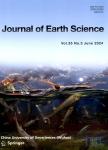Deep Mechanical Background for the Cenozoic Volcanism in the Tibetan Plateau
Deep Mechanical Background for the Cenozoic Volcanism in the Tibetan Plateau作者机构:Institute of Geodesy and Geophysics Chinese Academy of Sciences Wuhan 430077 China Institute of Geology and Geophysics Chinese Academy of Sciences Beij ing 100101 China Graduate School Chinese Academy of Sciences Beijing 100038 China Institute of Geology and Geophysics Chinese Academy of Sciences Beijing 100101 China
出 版 物:《Journal of China University of Geosciences》 (中国地质大学学报(英文版))
年 卷 期:2005年第16卷第4期
页 面:334-339页
核心收录:
学科分类:070904[理学-构造地质学] 0709[理学-地质学] 07[理学] 0708[理学-地球物理学] 0704[理学-天文学]
基 金:ThispaperisfinanciallysupportedbytheNationalNaturalScienceFoundationofChina(Nos.40274037 40474028)andChineseAcademyofSciences(KZCX3SW153)
主 题:mantle convection stress field Tibetan plateau volcanism magma channel.
摘 要:The principle prerequisite for the formation of a volcano is the generation of a channel for magma transportation. There is little research on the deep mechanical mechanism for the formation of a magma transportation channel in the Tibetan plateau. Based on the subcrustal mantle convectiongenerated stress field inversed by gravity anomalies, together with its relationship to the Cenozoic volcanism in the plateau, and the mechanism of crustal fracture formation, as well as the numerical results of the evolution of mantle convection beneath the plateau, this paper investigates the deep mechanical mechanism for the formation of a magma transportation channel in the Tibetan plateau. There are two significant extensional convection-generated stress zones beneath the plateau, in which the volcanic rocks in the central and northern parts of the plateau are distributed. The Linzizong volcanism in southern Tibet correlates the upwelling mantle flow prior to the India-Asia collision or during the early stage of the collision. The magnitude of the stress is - 100 MPa, which is the same order of force that causes crustal fractures. The evidence implies that the mantle convection-generated stress is one of the principle causes of crustal fractures, and furthermore, the formation of the magma transportation channel in the Tibetan plateau.



